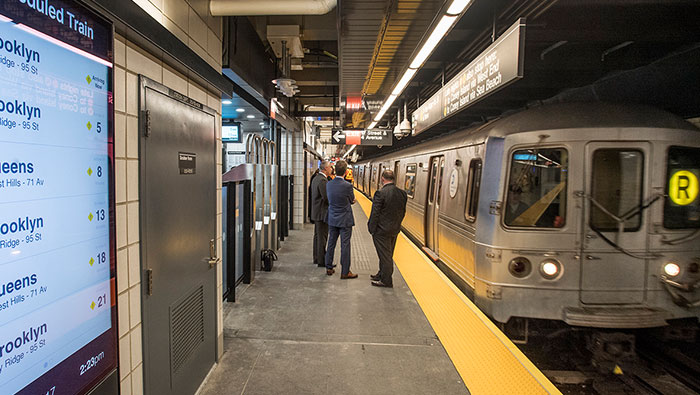Photo Courtesy of MTA/Patrick Cashin
Months of testing have led to the increasing of five speed limits between 36 St and 59 St on the NR line in Brooklyn, with 15 mph zones being increased to 20 or 30 miles per hour.
By Forum Staff
The Metropolitan Transportation Authority seems to feel the need for speed.
As part of the agency’s “Save Safe Seconds” campaign to improve subway performance, New York City Transit has begun correcting antiquated speed limits and fixing faulty speed-regulating signals, known as “grade time signals,” throughout the subway system. Last weekend, NYCT increased five speed limits between 36th Street and 59th Street on the NR line in Brooklyn, with 15 mph zones being increased to 20 or 30 mph. Twenty-nine more increases throughout the system have also been approved by a safety committee and will be rolled out in coming weeks, with NYCT officials estimating speed limits to be safely increased at more than 100 locations throughout the system by the springtime. The speed limit changes already approved increase speeds generally in the 10 to 20 mph range to speeds that reach the 40s, according to agency officials.
The same team of engineers, safety agents, and union officials working on correcting antiquated speed limits is also testing and fixing speed regulating signals called “timer signals,” with 95-percent of some 2,000 such signals tested since the initiative began in late August. Approximately 267 faulty timer signals have been discovered and roughly 30 of them have been fixed so far in what amounts to very labor-intensive work to inspect, diagnose, and repair or replace numerous possible pieces of equipment during times of exclusive track access for workers such as weekends or nights.
The MTA noted that as operators are trained to proceed with safety as the primary factor, train speeds through any given area are impacted by many factors in addition to speed limits, such as congestion, unplanned diversions, equipment issues or track work. The positive effects of speed-limit changes may be felt immediately under optimal conditions and after a period of operator acclimation to the new limits. The positive effects of timer signal repair work will be felt more long-term, as long segments of timer signal repairs must be completed before bulletins are issued and train operators are acclimated.
In 2018, Byford took a look at the entire system with an eye towards improving service safely and an emphasis on listening to customers and front-line employees about their experiences. Timer signals were a frequent topic, and Byford instructed his team to investigate the issue and assemble a methodology by which timer signals could be completely surveyed, tested, inspected, and repaired.
“Safety is always our top priority, and we’re working hard to maximize our subway’s potential within the boundaries of stringent safety standards,” said NYC Transit President Andy Byford. “Subway cars have come a long way in safety and performance since the system’s speed limits were first put in place up to a century ago, and some speed-regulating signals have become miscalibrated over time, forcing trains to go slower than they need to. We’re taking a fresh look, with no compromise to safety, at how to reduce delays and get people to their destinations sooner.”

